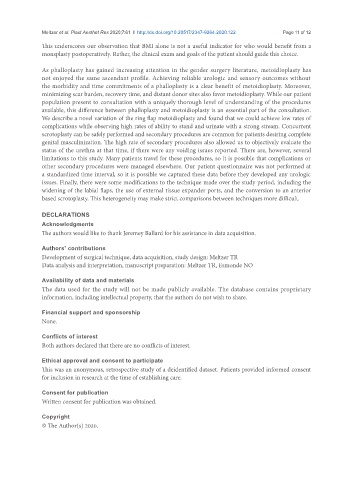Page 723 - Read Online
P. 723
Meltzer et al. Plast Aesthet Res 2020;7:61 I http://dx.doi.org/10.20517/2347-9264.2020.122 Page 11 of 12
This underscores our observation that BMI alone is not a useful indicator for who would benefit from a
monsplasty postoperatively. Rather, the clinical exam and goals of the patient should guide this choice.
As phalloplasty has gained increasing attention in the gender surgery literature, metoidioplasty has
not enjoyed the same ascendant profile. Achieving reliable urologic and sensory outcomes without
the morbidity and time commitments of a phalloplasty is a clear benefit of metoidioplasty. Moreover,
minimizing scar burden, recovery time, and distant donor sites also favor metoidioplasty. While our patient
population present to consultation with a uniquely thorough level of understanding of the procedures
available, this difference between phalloplasty and metoidioplasty is an essential part of the consultation.
We describe a novel variation of the ring flap metoidioplasty and found that we could achieve low rates of
complications while observing high rates of ability to stand and urinate with a strong stream. Concurrent
scrotoplasty can be safely performed and secondary procedures are common for patients desiring complete
genital masculinization. The high rate of secondary procedures also allowed us to objectively evaluate the
status of the urethra at that time, if there were any voiding issues reported. There are, however, several
limitations to this study. Many patients travel for these procedures, so it is possible that complications or
other secondary procedures were managed elsewhere. Our patient questionnaire was not performed at
a standardized time interval, so it is possible we captured these data before they developed any urologic
issues. Finally, there were some modifications to the technique made over the study period, including the
widening of the labial flaps, the use of external tissue expander ports, and the conversion to an anterior
based scrotoplasty. This heterogeneity may make strict comparisons between techniques more difficult.
DECLARATIONS
Acknowledgments
The authors would like to thank Jeremey Ballard for his assistance in data acquisition.
Authors’ contributions
Development of surgical technique, data acquisition, study design: Meltzer TR
Data analysis and interpretation, manuscript preparation: Meltzer TR, Esmonde NO
Availability of data and materials
The data used for the study will not be made publicly available. The database contains proprietary
information, including intellectual property, that the authors do not wish to share.
Financial support and sponsorship
None.
Conflicts of interest
Both authors declared that there are no conflicts of interest.
Ethical approval and consent to participate
This was an anonymous, retrospective study of a deidentified dataset. Patients provided informed consent
for inclusion in research at the time of establishing care.
Consent for publication
Written consent for publication was obtained.
Copyright
© The Author(s) 2020.

